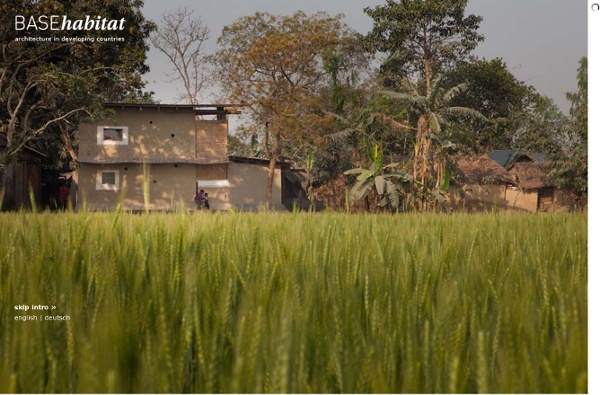



Public Architecture Solutions must be accepted by the people Unser Name BASEhabitat verdeutlicht den sehr selbstbestimmten Anspruch an Lehre und Forschung unserer Institution. Entsprechend eigenständig und grundsätzlich versuchen wir den Gegenstand dieses Lernens und Forschens, den Raum, zu begreifen. Dabei wollen wir den Menschen in den Mittelpunkt rücken als das Wesen, das sich mit dem Raum umhüllt, um sich ein Zuhause zu geben, um geschützt zu sein vor widrigen Umwelteinflüssen, um sich einen Ort zu schaffen, der sein Dasein fördert und bereichert, an dem sich Zukunft denken lässt. Wir suchen die Herausforderung an unsere Baukunst auch dort, wo selbst jene grundlegendsten Anforderungen an den gebauten Lebensraum nicht erfüllt sind. Deshalb haben wir mit BASEhabitat ein Projektstudio eingerichtet, das Theorie und Praxis zu Projekten bündelt, die mit den Mitteln von Bautechnik und Raumkunst einen Beitrag zur nachhaltigen Verbesserung und Erhaltung der Lebensqualität in Entwicklungsländern leisten. Über Schönheit spricht man nicht.
Housing Revolution: Better, safer, smarter, more sustainable dwellings Architecture for Humanity Green Prefab Shed Homes: Small Space Living by Design Continue reading below Our Featured Videos Sheds do not sound like something you would want to live in, but as modern modular, mobile and miniature houses become increasingly popular sustainable living space options, well, even products dubbed with titles like the Big Shed and Little Shed is not such a bad idea. There is an art to designing smalls-space structures so they are convenient and compact but also comfortable and livable – and a certain lifestyle of simplicity sought by many that makes them a good match for some people.Plus, these designs by Dwelle are relatively affordable as home prices go: you can buy ones of these all-in-one buildings (and not worry about the hassles of construction) for between fifty and eighty thousand dollars. Newsletter Sign Up Get the latest design news! Sign up for our newsletter and get the latest design news. Thanks for subscribing!
Design humanitaire | Ça Blog - Ça m’intéresse Cooper-Hewitt National Design Museum A New York, le Cooper-Hewitt Museum, musée national du design, organise jusqu’au 23 septembre une passionnante exposition intitulée “Design pour les 90% restants”. C’est-à-dire une sélection d’objets et produits conçus pour simplifier (voire sauver) la vie des 5,8 millions de Terriens les plus démunis. Voici une sélection de quelques idées aussi astucieuses qu’utiles… Q Drum – un bidon en forme de roue, en polyéthylène, qui contient 75 litres et se tire avec une corde, faisant de la corvée d’eau un jeu d’enfant (qu’on voit en action ci-dessus). Fabriqué en Afrique du Sud, il est déjà utilisé dans 10 pays du continent noir : Katrina Furniture Project – Des étudiants en art aident les victimes de l’ouragan Katrina, en Louisiane, à réaliser du mobilier en bois (comme ce banc d’église) avec des débris. AquaStar Plus! Solar Aid – Dans les prothèses auditives pour malentendant, ce qui coûte le plus cher, ce sont les piles.
The Fab Lab House wins Solar Decathlon Europe people’s choice award « FabLab House The Fab Lab House wins Solar Decathlon Europe people’s choice award More than 20,000 people have visited the most popular solar house in Madrid, produced by the Institute for Advanced Architecture of Catalonia (IAAC). IAAC announced that will apply in the next edition of Solar Decathlon Europe in 2012. Prince Felipe said it looked like a boat but the spectacular house produced by Institute for Advanced Architecture of Catalonia was also called “peanut house” “cinnamon submarine,” “forest zeppelin” or “whale belly” . The queues to visit the house have greatly surprised the team of the Fab Lab House during the ten days of competition: more than 20,000 people have visited the solar house. The team has been awarded with the people’s choice award, ex aequo with the University Cardenal Herrera. “The competition has been a great way to push the spirit of innovation in the field of architecture and construction in these times of crisis. Fotos Adrià Goula
Les recettes de grand-mère, un remède à la crise et une solution pour la planète ? Les secrets de nos grands-mères permettent souvent d’éviter l’utilisation de produits chimiques polluants et chers Les recettes de grand-mère reviennent à la mode ! Sous l’effet combiné de la prise de conscience écologique et de la crise financière, on redécouvre les secrets de nos chères aïeules, qui peuvent parfois être synonymes de bon sens écologique, notamment en ce qui concerne le nettoyage de la maison, la cuisine et l’entretien du linge. Ils sont en effet des alternatives crédibles aux produits chimiques, polluants, coûteux et pas forcément toujours efficaces. Voici une sélection des dix meilleures recettes de grand-mère qui vous permettront de concilier écologie et économie : - Le marc de café, qui peut être utilisé pour dégraisser, nettoyer et faire briller le cuir. - L’huile d’olive, qui outre ses vertus culinaires permet de détacher, de nourrir et de faire briller les meubles en bois. - Le savon de Marseille est un excellent nettoyant naturel.